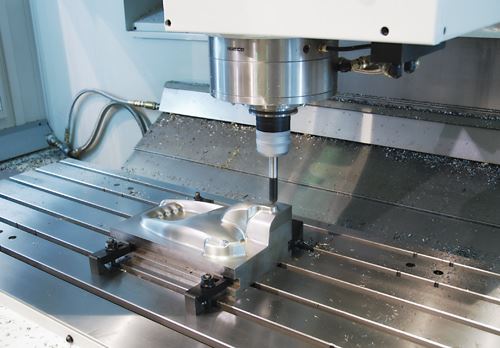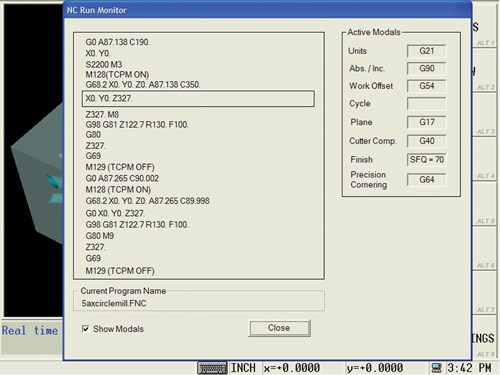How to Get the Most Out of Your Control
If the spindle is the heart of the machining center, the control is the brain. This article will help you explore whether it’s time to expand your brain and find new efficiencies to increase profitability.
First, we’ll discuss technology maximization, a techie term for identifying overlooked software features that could maximize productivity. The second section covers training assessment, and how a small investment could lead to more customers and/or more projects from existing customers. Finally, we’ll review technology upgrades and tips on how to keep on top of emerging technology that could make your business more profitable.
Old Dog. New Tricks.
Are you maximizing your control’s technology features? It’s easy to get complacent and rest on your laurels when it comes to process efficiency. You’ve invested time and money in getting the right people and the right CAD/CAM system, and they both work well. But could everything work better?
Continual improvement is the primary goal. For instance, if your control has shop floor features, you can maximize the productivity of both your operator and your CAD/CAM department by trying something new. Utilize the CAD/CAM programmer for 3-D features of the part, yet save time by allowing the simple 2-D features to be programmed at the machine—this gives you the best of both worlds!
Your control might have conversational programming that you’ve never even evaluated. Due to advancements in user interface design and software capabilities, many features that used to be complex have been simplified for the user, which means you can maximize each employee’s participation in the process.
Do You Know Your Control Inside and Out?
Evaluating the controls on your current equipment is important to understanding future needs. What’s holding you back? Do you have to drip feed programs because your control doesn’t have enough memory? Would different connectivity options be helpful, such as USB or Ethernet? Is the control’s graphics program useful for test runs? For instance, run time graphics combined with an interrupt button let the operator see where he is in the cut, which saves valuable time. Once you know what you need, it’s time to find out the full capabilities of your control and assess training needs. You might be surprised.
You’ve probably heard the story of the woman who cut off both ends of the pot roast before cooking it. When her husband asked her why, she said her mom always did that way. The logic-seeking husband then asks his wife’s mother, and she doesn’t know either. “That’s how my mother always did it.” Now obsessed, the husband asks his wife’s grandmother why she always cut off the ends of the pot roast before cooking it. Is it a tradition? Does it make the meat taste better or cook faster?
“Oh,” replies the grandmother, “I had to cut off the ends because my roasting pan was too small to fit an entire roast.”
Trickle-down training often yields a similar result. Oftentimes, a company will send one person to training. When he returns, he shares his knowledge with existing employees and trains new employees as they are hired. It can be cost-effective at first, but over time there could be robust features or faster processes that would benefit your business that are missed. When people are taught why they are doing something, there is a better chance they will be able to use their cerebral skills to gain a fuller understanding of the technology, which often results in identifying a better way to get the job done.
Is It Time to Upgrade?
It’s important to realize that the software that runs the con-trol is continually being refined and improved as software engineers develop new features, create new algorithms, perfect code and find new ways to make the control better. Continual improvement is the core of innovation, and software development makes it possible like no other time in history.
Find out if your current control would benefit from an upgrade. Some companies publicize the advantages of new version releases and market new versions. So, if what you’re doing is working, how do you decide whether an upgrade is available and even worth the hassle?
- Find out if your manufacturer offers upgrades.
- If they do, contact the person you have found to be the most knowledgeable about your machine tool’s control—
- it might be the applications engineer, your sales rep or a service technician.
- Do a cost/benefit analysis. What jobs are you doing now and how long do they take. If you upgrade, what will you
- get and how will that save you time on each job? Better yet, let the sales rep do that for you. “How much time will I save if I upgrade?” is your question. If it doesn’t save time, it’s not worth the headache or the money. It’s about time—less time to setup, which makes each job more profitable and gives you time to get more business.
- The next question: “How will a software upgrade expand my capability, so I can do jobs that I can’t do today or jobs that require too much time to be profitable?”
- Find out if there are specialized features that address your shop’s unique needs.
For example, one manufacturer’s upgrade includes an NC cylindrical wrap feature. This is a huge advantage if you are using a 4-axis or 5-axis machine because you can wrap 3-axis milling features around a cylinder on 4-axis or 5-axis machines. The cylinder can have any orientation and you don’t need to align it to the machine’s rotary axes centerlines. You can also do inside cylinder wrapping. Another feature included in a new CNC software upgrade is an NC tool review that eliminates the need to search the program for tool change commands because a list of blocks with tools used is displayed automatically.
Summary
In addition to new features, enhancements to a feature your control currently has could benefit you significantly. For example, one machine tool manufacturer with its own control made significant enhancements to its NC editor to include PC text editor commands, such as do/undo, cut, copy, and paste. An upgrade might include meaningful additions of industry standard G-codes and Macro B, and/or additional work offsets and tool offsets. Often, a software upgrade yields machine performance improvements, such as better surface finish with 600-block look ahead.
Another consideration to determine whether an upgrade would benefit your operation includes technical specifications, such as increased RAM that allows the user to restart the program without the need to insert a new header. Find out if the upgrade includes technical improvements, such as faster boot-up time or better surface finish. Technology continues to evolve, and you don’t want your shop to get left behind.
Related Content
MMT Chats: The Connection Between Additive Manufacturing Education and ROI
This MMT Chat continues the conversation with Action Mold and Machining, as two members of the Additive Manufacturing team dig a little deeper into AM education, AM’s return on investment and the facility and equipment requirements to implement AM properly.
Read MoreMMT Chats: Eliminating the Noise to Stay Focused on the Customer
Metro Mold & Design joins me to discuss the value of the 80/20 rule as a business strategy, its talented cross-functional team, the role of automation in mold building and molding, and the continuing impact of COVID-19.
Read MoreWhat is Scientific Maintenance? Part 2
Part two of this three-part series explains specific data that toolrooms must collect, analyze and use to truly advance to a scientific maintenance culture where you can measure real data and drive decisions.
Read MoreDynamic Tool Corporation – Creating the Team to Move Moldmaking Into the Future
For 40+ years, Dynamic Tool Corp. has offered precision tooling, emphasizing education, mentoring and innovation. The company is committed to excellence, integrity, safety and customer service, as well as inspiring growth and quality in manufacturing.
Read MoreRead Next
Consider The Control Before You Buy
Your machining center’s control could mean the difference between rapid productivity and costly downtime.
Read MoreReasons to Use Fiber Lasers for Mold Cleaning
Fiber lasers offer a simplicity, speed, control and portability, minimizing mold cleaning risks.
Read MoreAre You a Moldmaker Considering 3D Printing? Consider the 3D Printing Workshop at NPE2024
Presentations will cover 3D printing for mold tooling, material innovation, product development, bridge production and full-scale, high-volume additive manufacturing.
Read More























.jpg;maxWidth=970;quality=90)